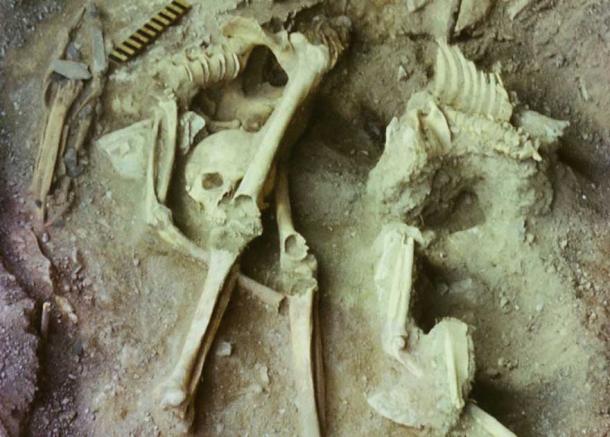
East-West Migration to Siberia Found in 7,500-Year-Old DNA
The Americas were settled by people who migrated across the Bering Sea land bridge that connected Siberia (North Asia) and North America during the last Ice Age, between 30,000 and 12,000 years ago. But while the movements of populations going from the west to the east had a profound impact on the history of the Americas, there was also an east-west migration, or counter flow, of people going in the other direction that also had a significant and transformational effect on the genetic and cultural history of Siberian and Northern Asian people.
While this east-west migration has long been hypothesized, a team of genetic scientists has now published an article in the journal Current Biology that proves reverse migrations took place and that they left a measurable signature behind in the DNA of the people who resided in Siberia and in adjacent regions during the Neolithic period (5,500 to 3,400 BC).

DNA sequenced from Altai hunter-gatherers has shed light on the genetic origins of Bronze Age groups across the Central Asian steppe, revealing east-west migration to Siberia. (Artur L. Kungurov / Current Biology)
Discovering a New Siberian People Through Genetics
For the purposes of this new landmark study, researchers affiliated with the Max Planck Institute for Evolutionary Anthropology in Germany collaborated with several Russian scientists to analyze DNA samples taken from the skeletal remains of 10 individuals who lived in ancient Siberia, some as long as 7,500 year ago.
Through the detailed genetic analysis that was performed, it was possible to trace the migration and settlement patterns of ancient peoples both during and before the Neolithic period that followed the termination of the last Ice Age and the flooding of the Bering Sea land bridge (the bridge was submerged completely about 11,500 years ago).
- Study of Ancient Teeth Reveals Native American Origins Lie in Siberia
- DNA Analysis Reveals Surprising South American Migration Patterns
Among some truly incredible findings, the researchers discovered that several of these individuals had belonged to a previously undetected Middle Holocene hunter-gatherer group that had resided in the Altai-Sayan region, very close to the place where modern-day Russia, China, Mongolia and Kazakhstan converge. This was also where the famed Denisovans were first discovered.
The members of this group were descended from both paleo-Siberian and ancient North Eurasian peoples, who migrated to the region from the east and west respectively. They in turn contributed their genetic heritage to other groups that passed through or lived in the area later.
“We describe a previously unknown hunter-gatherer population in the Altai as early as 7,500 years old, which is a mixture between two distinct groups that lived in Siberia during the last Ice Age,” study senior author and paleogeneticist Cosimo Posth said in an interview published in the digital publication Open Access Government. “The Altai hunter-gatherer group contributed to many contemporaneous and subsequent populations across North Asia, showing how great the mobility of those foraging communities was.”
It should be noted that it has been difficult for scientists to obtain enough DNA samples from ancient residents of Northern Asia to make many definitive conclusions about their genetic histories. That is why the results of this new research project are so groundbreaking.

Aerial image of the showing Alaska, the Bering Strait and Siberia. (Anton Balazh / Adobe Stock)
West-East and East-West Migrations To and From Siberia
In addition to its discovery of a new ancient Siberian people, the study by the German and Russian scientists also produced another remarkable result. Three of the 10 individuals whose DNA was studied during the project died only 500 years ago and were laid to rest along Siberia’s Kamchatka River. While these people were related to modern-day residents of the Kamchatka region, they also carried DNA that could be directly traced to the indigenous people of North America.
Based on the various genetic linkages detected, the German and Russian scientists concluded that the genetic makeup of the three individuals is best explained by genetic mixing events that occurred approximately 5,000 and 1,500 years ago. In other words, ancient Alaskans sailed across the Bering Sea in approximately 3,000 BC and again in 500 AD, and in both instances settled in Siberia and interbred with the people living there.
Three years ago, researchers involved in another study found evidence to suggest that between 2,200 and 500 years ago, indigenous people from Alaska had sailed across the Bering Sea and landed and settled in Siberia. But as this new discovery shows, this type of reverse east-west migration has been going on for a lot longer than that. In fact, it’s possible that population movements back and forth between North Asia and North America never really stopped, even after it became impossible to make the crossing by land.
“We’re not able to say how many times these gene flow events occurred over the past 5,000 years,” Posth stated. “What we’re trying to say is that it could have been multiple, repeated events, or it could have been gradual, constant, continuous. It’s difficult to say, but clearly… it was a prolonged event.”

The skull of the Nizhnetytkesken individual which has provided genetic evidence used in the study. (Sergey V. Semenov)
A Crossroads for Genetics and History
The new study produced even more fascinating revelations. For example, the researchers detected ancient Northeast Asian ancestry in the genome of one individual found in the Altai-Sayan region. Ancient Northeast Asian ancestry was previously believed to have been confined to Russia’s Far East, but the DNA sample that contained this genetic signature was found approximately 930 miles (1,500 kilometers) farther west than such DNA had ever been found before.
In another eye-opening discovery, the researchers uncovered genetic traces in one individual that linked him to the Jomon, a hunter-gatherer group that lived on the Japanese archipelago. Yet another of the people studied was apparently a shaman, given the eclectic collection of ceremonial objects that were found in his tomb which was located near the Russian city of Nizhnetytkesken.
“The finding that surprised me the most is from an individual dated to a similar period as the other Altai hunter-gatherers but with a completely different genetic profile, showing genetic affinities to populations located in the Russian Far East,” said study lead author Ke Wang, a geneticist from Fudan University in China.
- It Looks Like America’s First People Were Island Hoppers
- Found! The Deepest Link Between Siberians and the First Americans
“It is not clear if the Nizhnetytkesken individual came from far away or the population from which he derived was located close by,” noted Wang when discussing the shaman. “However, his grave goods appear different than other local archeological contexts implying mobility of both culturally and genetically diverse individuals into the Altai region.”
Taken all together, the findings of this exhaustive and unique genetic study show that ancient Siberia and the surrounding region was a crossroads for peoples migrating in all directions in ancient times. Genetic connections between these various groups that occupied or traveled through North Asia were apparently formed as early as 10,000 years ago, which has now finally been revealed thanks to sophisticated techniques of modern genetic analysis. “This suggests that human migrations and admixtures were the norm and not the exception also for ancient hunter-gatherer societies,” Posth concluded.
Top image: Representational image depicting east-west migration to Siberia by hunter-gatherers. Source: Gorodenkoff / Adobe Stock
By Nathan Falde
















Comments
“Yet another of the people studied was apparently a shaman, given the eclectic collection of ceremonial objects that were found in his tomb which was located near the Russian city of Nizhnetytkesken.”
In other words, the guy was likely pre-Ice Age, and buried down in his cavern when the calamity struck. Oh, how they just so fast to the typical silliness. Of course they don’t date the bones, but the sediments, which came much later.
Nobody gets paid to tell the truth.